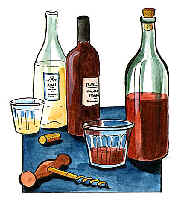
![]()

Bayou Lacroix Vineyards | Email | Basic Winemaking | Advanced Winemaking Email | Basic Winemaking | Advanced Winemaking Email | Basic Winemaking | Advanced Winemaking | Nylon Straining Bags | Sugar | Acidity
|
 These are nylon mesh bags used for fruit
and pulp fermentation, as they allow you to contain the fruit for easy
removal. They come in a fine mesh and a coarse mesh are very
inexpensive. If you have ever had to scoop out fruit from a fermenter
you will understand the usefulness of these bags. Depending on how much
wine you are making, use either a small fruit bag or a large one. For 5
gallons of wine, you will need a large bag. Generally you place the cut
up fruit into the bag and tie of the top of it with a string of some
sort. Place the fruit filled bag into the bottom of your primary
fermenter and crush it the best you can with your hands, this helps to
extract juice. you then pour your water either hot or cold over the
fruit and add your wine chemicals and sugar. you leave the fruit filled
bag in the must for 3-5 days and allow the yeast to work on the fruit.
You then remove the fruit bag and discard the mushy fruit that is left
inside of it. the Bag can then be washed real good and hung up to dry,
and will be ready to the next use. You may use a sterilized panty hose
in a pinch, as if will facilitate letting the yeast in, and still
contain the fruit fairly well, although may not hold the amount of fruit
that you want to use. These are nylon mesh bags used for fruit
and pulp fermentation, as they allow you to contain the fruit for easy
removal. They come in a fine mesh and a coarse mesh are very
inexpensive. If you have ever had to scoop out fruit from a fermenter
you will understand the usefulness of these bags. Depending on how much
wine you are making, use either a small fruit bag or a large one. For 5
gallons of wine, you will need a large bag. Generally you place the cut
up fruit into the bag and tie of the top of it with a string of some
sort. Place the fruit filled bag into the bottom of your primary
fermenter and crush it the best you can with your hands, this helps to
extract juice. you then pour your water either hot or cold over the
fruit and add your wine chemicals and sugar. you leave the fruit filled
bag in the must for 3-5 days and allow the yeast to work on the fruit.
You then remove the fruit bag and discard the mushy fruit that is left
inside of it. the Bag can then be washed real good and hung up to dry,
and will be ready to the next use. You may use a sterilized panty hose
in a pinch, as if will facilitate letting the yeast in, and still
contain the fruit fairly well, although may not hold the amount of fruit
that you want to use.
|
 Proper acidity in a wine is of the utmost importance. I
wont go into the advanced explanations here, because its covered in the
advanced winemaking sections, but I will endeavor to give the basic or
novice home winemaker all the needed information on this subject. Wine
low in acidity is most always flat, medicinal, and insipid. Wine that is overly
acidic is usually tart. Acidity and PH in a wine go pretty much hand in
hand, if the acid is low the PH will be higher. A wine with high PH
values is susceptible to bacterial infection. I cant stress enough how
important proper acid levels in a wine affect the taste. To much acid in
a wine will ruin the taste and the wine in my opinion. A high acid wine
is a common mistake young winemakers make, I can attest to this
because I have been there done that!! Fruit wines especially are
delicate when it comes to acid levels. Always do an acid test on your
must prior to adding yeast if at all possible. Acid test kits are very
inexpensive and well worth the small cost. Acid levels in a wine will
affect the taste, the longevity, how stable it is, and many other
factors. It is easier to add acid to a wine, than it is to reduce the
acidity of a finished wine. Follow these guide lines and you will always
have a balanced wine. Proper acidity in a wine is of the utmost importance. I
wont go into the advanced explanations here, because its covered in the
advanced winemaking sections, but I will endeavor to give the basic or
novice home winemaker all the needed information on this subject. Wine
low in acidity is most always flat, medicinal, and insipid. Wine that is overly
acidic is usually tart. Acidity and PH in a wine go pretty much hand in
hand, if the acid is low the PH will be higher. A wine with high PH
values is susceptible to bacterial infection. I cant stress enough how
important proper acid levels in a wine affect the taste. To much acid in
a wine will ruin the taste and the wine in my opinion. A high acid wine
is a common mistake young winemakers make, I can attest to this
because I have been there done that!! Fruit wines especially are
delicate when it comes to acid levels. Always do an acid test on your
must prior to adding yeast if at all possible. Acid test kits are very
inexpensive and well worth the small cost. Acid levels in a wine will
affect the taste, the longevity, how stable it is, and many other
factors. It is easier to add acid to a wine, than it is to reduce the
acidity of a finished wine. Follow these guide lines and you will always
have a balanced wine.
There are basically three kinds of acid in wines.
This is for a 5 gallon batch or wine!!
|
|
Sugar is an essential part of winemaking. You can not make wine without sugar or something for the yeast to work on. Pure cane white sugar is the best, but you can use glucose sugar as well. Substances that contain sugars such as honey may also be used. I recommend using honey only if you are going to make a mead, or give the wine a slightly different flavor. In the later case, use mostly sugar but add a few cups of honey along with it. Without sugar your wine would contain no alcohol, so in perspective the less sugar in a wine must, the lower the alcohol content will be. Measuring the amount of sugar in your must is a very important part of winemaking and should not be over looked. Sugar is the back bone to any unfermented juice, and its what the yeasts are after when they are placed into the must. Keeping sugar a correct levels prior to fermentation will ensure a finished wine with a balanced or acceptable alcohol level. The desirable alcohol level is usually around 12.5% alcohol by volume. To simply follow a recipe is to guess at the sugar level, thus you are guessing at the finished alcohol level in your wine. A finished wine should have balance between sweetness, acidity, and alcohol. A wine competition judge will always look at these features in a wine, along with other constituents. In general if you want a wine to finish at 12.5% alcohol per volume, you will need to add 32oz of sugar per gallon to the must. A cup of sugar is 8oz. so for a 5 gallon batch of wine, you normally would add about 20 cups of sugar. This is just a general guideline, there is no substitute for measuring your sugar content with a hydrometer. Using a hydrometer will give you an accurate reading of sugar in a must, and allow you to correct it very accurately. As general rule, and if you dont have a hydrometer use about 2 /12 pounds of sugar per gallon of finished wine you want to produce. |
|
Copyright © 1999 Bayou Lacroix
Vineyards. All rights reserved. Guest Book | Email Winemaker | Bayou Lacroix Vineyards | Home |